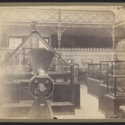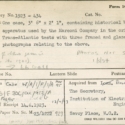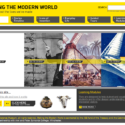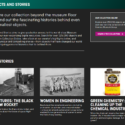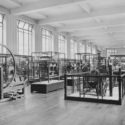Origins and ambitions of the Congruence Engine project
Abstract
https://dx.doi.org/10.15180/221801/001The Congruence Engine project arises from museum practice, especially that of the Science Museum; its origins are in the character of curatorial work and also in the frustrations that often arise when seeking to democratise access to the extraordinary cultural capital that sits unrealised in collections, especially reserve collections. It is built on an appreciation of the differing kinds of relevant research practice, now united in the conduct of the project: curatorial, academic, social and digital. The origins are, of course, also in the character of the collections that we draw on, in which context their history is deeply significant: the total national collection is made up of idiosyncratic components. The Towards a National Collection funding scheme aims to actualise potentials that arise from the heritage sector’s digital practice over the last decades. Here too the history is relevant, because our potential practice is constrained by old decisions about what and how collections should be digitised and informed by the first decades of practice in database use and online content. The diversity of working cultures that combine in heritage digital practice is also a factor. Many of the project’s ambitions have been brewing in the Science Museum Group’s Research Department practice since its origins in 2010: public and intermedial history, participatory practice and, overall, an assertion of the importance of research to museum futures. After discussing the project, the article finishes with ideas for two potential investigations.
Keywords
action research, collections, curation, digital humanities, digitisation, Interdisciplinarity, multidisciplinarity, museum history, participatory practice, Research in museums
Introduction
https://dx.doi.org/10.15180/If the role of research in 21st-century museums should itself ever become the subject for historical research, then it will be possible to produce an objective, dispassionate account of what has happened especially over the last decade and a half, as external funding and institutional purpose have together enabled something of a heyday. For the moment, what follows bears the mark of autobiography for me as Head of Research for the Science Museum Group, reflecting on what has seemed important and pertinent to a modern science museum’s research culture. If there is an acceptable justification for this, then it lies in the importance of reflexivity in research conduct, which is a notable characteristic of the action research methodology we are following in Congruence Engine (see essay by Helen Graham and Arran Rees, this issue).
Few books have had more influence on me than Michel de Certeau’s The Practice of Everyday Life (1984) did twenty years ago. Just occasionally, it is possible to chance on a work of analysis or theory that fits like a key a lock one has been trying to open, and such was the case here. De Certeau describes cultural consumption – the subject of his book – as a form of production defined by the protagonist’s tactics within particular contexts. He uses examples of consumption-as-production – including the poacher bagging a rabbit on someone else’s land, the sense made of cities by pedestrians, the exercise of wit, and storytelling – to convey his model of cultural consumption. I can remember hungrily reading its chapters, blindsided by the clarity that they were bringing not only to my practice as one of the curators of the Making the Modern World gallery at the Science Museum (opened 2000), but also to my research into the history of science and medical films (Boon, 1999, 2011b).
For more than a decade I have thought that De Certeau’s descriptive phrase of being ‘immersed in practice’ essentially captured the spirit needed for developing the Science Museum Group’s (SMG’s) research enterprise. Finding a route through the then largely unmapped territory of the Science Museum’s potential for research was very much a matter of being ‘immersed in practice’, responding with my ‘gut’ to the needs of the Museum in the context of the opportunities that presented themselves, especially through focused funding calls. Nothing is created de novo, of course; it is true that I had always seen my curatorial work as a mode of doing the history of science (Boon, 2010) and was supervising my first doctorate nearly twenty years ago (Geoghegan, 2008). But the task I was given – to enable a more academic research culture for an organisation where research had been a minor activity – placed me in new territory with new opportunities.
The latest highly relevant research opportunity is the Towards a National Collection (TaNC) funding stream, which has backed Congruence Engine as one of five major Discovery Projects.[1] This funding could not have become a reality had not the Arts and Humanities Research Council (AHRC) already been working closely with the nation’s galleries, libraries, archives, museums and historic environment organisations (together the GLAM sector). This closeness was itself a product of the AHRC’s Independent Research Organisation (IRO) scheme, which since 2007 has permitted non-university organisations with an active research culture to apply for IRO status, the award of which confers the right to apply for research funding on an equal footing with Higher Education Institutions. SMG has held this status since 2009, and this has had a revolutionary enabling function for us. The AHRC’s application to its parent body UK Research and Innovation (UKRI) to fund TaNC was a response to UKRI’s initiative to invest in research infrastructure. Whereas for physics this infrastructure might be equipment such as particle accelerators or radio telescopes, it was agreed that for the arts and humanities collections of all kinds are the infrastructure that enables research to continue. The purpose of the £18.9 million TaNC fund is to research how it can be rendered possible to search, and to work across, the nation’s collections, using digital technique to unite collections whose cataloguing status is highly variable, and where standardisation of cataloguing has not yet enabled any significant degree of interoperability.
The Congruence Engine project is both a response to the needs outlined in the TaNC funding call and the culmination of long-term research concerns of the IROs and the Science Museum Group in particular. This essay discusses where the project came from, and how it can also continue to develop research questions from established areas of practice and research. In the sections that follow, I outline some of the conditions of possibility for Congruence Engine as they seem to me, the main author of the funding bid. Throughout I seek to indicate how the project, with its roots in several kinds of soil, might be nurtured to grow and bear fruit over its three-year term and beyond.
Origins
https://dx.doi.org/10.15180/221801/002Museum curatorship (my working definition here includes all aspects of working with collections of artefacts and images, including those now most often separated out into distinct functions and professions) is, most of the time, a pragmatic business. Its activities range from aspects of audit (how do we locate the objects in our care?) to kinds of creativity (what objects shall we put together to represent a narrative? How can the collection be extended to represent new areas?) and much in-between. Congruence Engine, as a museum-led project, has a declared objective to represent museum culture within the set of Discovery Projects. Some of the topics discussed in this section relate to museum practice generally – such as the development of the Science Museum as a particular kind of technical museum, or the Museum’s changing digital practice and the consequent creation of new professions. Other topics derive from the specific concerns that have emerged over the dozen years of the Science Museum Group Research Department’s existence, including public history of science, participatory practice and intermedial study, all of which are also visible across the Department’s activities: masters and doctoral training, research projects and events and, of course, this journal.
Museum as Method
The core humanities research traditions of museums (and indeed most heritage organisations) differ from the norms of the Academy. As a broad generalisation, whereas the university traditions start within discourse with empirical study and analysis of texts undertaken within developing theoretical and historiographical conventions, museum research styles tend to start from the object and work by, for example, pursuit of provenance or the locating of items within meaningful historical contexts to create satisfactory displays, in traditions that the Cambridge anthropologist and museum director Nick Thomas calls ‘museum as method’ (2010). For him, there are three defining ‘moments’ of museum as method: the encountering of collection items in the store; juxtaposition of different objects together; and the labelling of things. For us here, juxtaposition is a particularly relevant mode that creates an associative kind of history; it suggests that intellectual links exist between the different contents of a display, both at the level of the case and of the entire exhibition. Juxtaposition suggests ‘these things belong together’; that they can be linked to suggest a historical account that may not, in the display, be explicitly stated. It is true, of course, that between the more discursive preferences of the Academy and the object-focus of museums and galleries there lies a burgeoning field of methodologies for the study of material things (see, for example, Hicks and Beaudry, 2010; Kingery, 1996). All the same, juxtaposition in particular is bound to be at the heart of the TaNC projects that seek to link items from across the nation’s collection for the sake of historical and curatorial work, as is the case with Congruence Engine. New approaches to linking the digital catalogue records of galleries, libraries, archives and museums promise the possibility of new kinds of historical practice that could build on these long traditions of museum display, by combining items from different collections into the same digital space. In the project, we are already, for example, bringing together museum inventories of machines, oral histories of people who worked in textile mills, both images and the metadata that describe them, and developing datasets of the detailed records held within archive sources such as censuses, street directories and lists of employment categories. We could almost be gathering the resources to curate an exhibition. And that is the point: this gathering together of data and digital copies of different kinds of evidence can enable modes of history that are associative in the same way that exhibitions associate differing components to construct an intermedial narrative. The resonance with Actor Network Theory (Latour, 2005) and the older prosopography (Stone, 1971) is clear: it is in the links and ‘fields’ between actors – which extend to things as well as people – that history is constructed.
Industrial Museums
The genealogy of modern science museums can more properly be traced to the Enlightenment era foundation of the Musée des Arts et Metiers in revolutionary Paris than to the foregoing culture of cabinets of curiosity (Alberti, 2022, pp 42–3). The Science Museum has always been dominated by machines and devices (technology as we would now say) rather than science, a state of affairs that has, on occasion, led to suggestions that it should change its name.[2] For most of its period of existence, and certainly after it became a separate institution in 1909, it squared the circle by asserting that technology was science applied; steam engines were applied thermodynamics and telescopes derived from optics (Bud, 2018). The Patent Office Museum, which shared the site of the South Kensington Museum (SKM) even though it was institutionally separate from it, was the earliest technical display on the site, from 1857 onwards.[3] But it was a display of inventions rather than of science. It featured many exhibits including, from 1862, Stephenson’s Rocket locomotive and Boulton and Watt’s Old Bess pumping engine as well as a substantial collection of portraits of inventors. In this sense, our collections at their origin were creatures of the so-called industrial revolution; even if they were collected before that term was in widespread usage (Coleman, 1992), they were preserved because Bennet Woodcroft, champion and creator of the Patent Office Museum, believed them to mark a key change in the world’s economy and society, ‘an archaeological collection referring to the lives of eminent mechanists [and an illustration of] the progress of mechanical inventions’ (Bud, 2010, p 15).
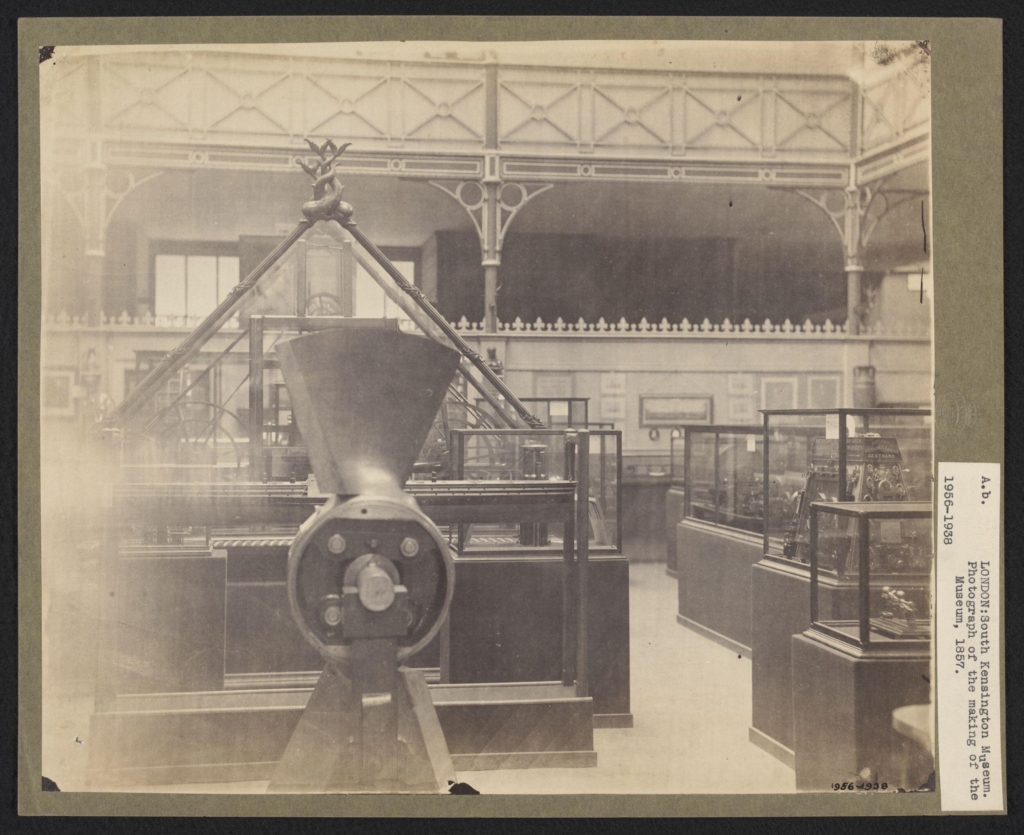
Because the Science Museum’s collections are predominantly technological, it made sense for our application for a TaNC Discovery project to build on this strength, even as we see the work of the project to be to look to the much wider set of industrial collections across the nation, notably those not primarily thought of as industrial, including the archives of the British Film Institute and the BBC. A Discovery project concerned, for example, with photographic collections (which was seriously considered after the funding was announced) could equally have been led by SMG, which retains one of the nation’s richest photograph collections even after the transfer of the Royal Photographic Collection to the V&A. But the industrial history subject is a signature concern for an SMG-led project, to which it can contribute records of one of the strongest collections in the field, with the older collection reinforced by the addition to the Group in 2012 of Manchester’s Science and Industry Museum (SIM).
But, for all that SMG’s collections are some of the strongest in existence for representing the history of industry, they are by no means definitive. The creation and development of collections is a profoundly idiosyncratic matter, very much contingent on the opportunities that arise to collect, and our antecedents’ beliefs, expertise and enthusiasms that interacted with those opportunities. If we are optimistic, we may see the complementarity of collections across the UK as one of the potential assets of the national collection re-imagined by TaNC. For example, it has become clear within the first months of the investigation that both the collections of the Science Museum and of SIM are dominated by machinery for cotton production, with rather little deriving from the woollen trade. It is advantageous to telling the broader story then that the Industrial Museum in Bradford does have a good collection associated with the woollen industry, despite the fact that it was founded as recently as 1970.
Digital museum practice
It would be easy to assume that the opportunities of digital practice in museums are new, whereas in fact a whole generation of Science Museum curators has grown up on digital practice, including the current author. David Williams’ brief history of museum computerisation to 1987 shows that our Museum was scarcely in the vanguard of practice; rather it would seem that it took advantage of a just-maturing technology (Williams, in Parry, 2009). In 1967, the idea of computer inventory had seemed very outlandish to the staff of the Science Museum; a Treasury Organisation and Methods report stated: ‘it is understood that the keepers and staff of the various departments are well acquainted with their buildings and experience no difficulty in locating exhibits. The use of a computer to maintain and process exhibit locations…does not therefore seem necessary’ (Treasury, 1967). But just 17 years later, the Museum’s Prime mini-computer for the processing of records of library books and museum objects was switched-on – in Spring 1984. Gradually, over several years, data processors typed in details of the Museum’s holdings, transferring them from the index cards – ‘Form 100’ – used by staff to audit their collections.
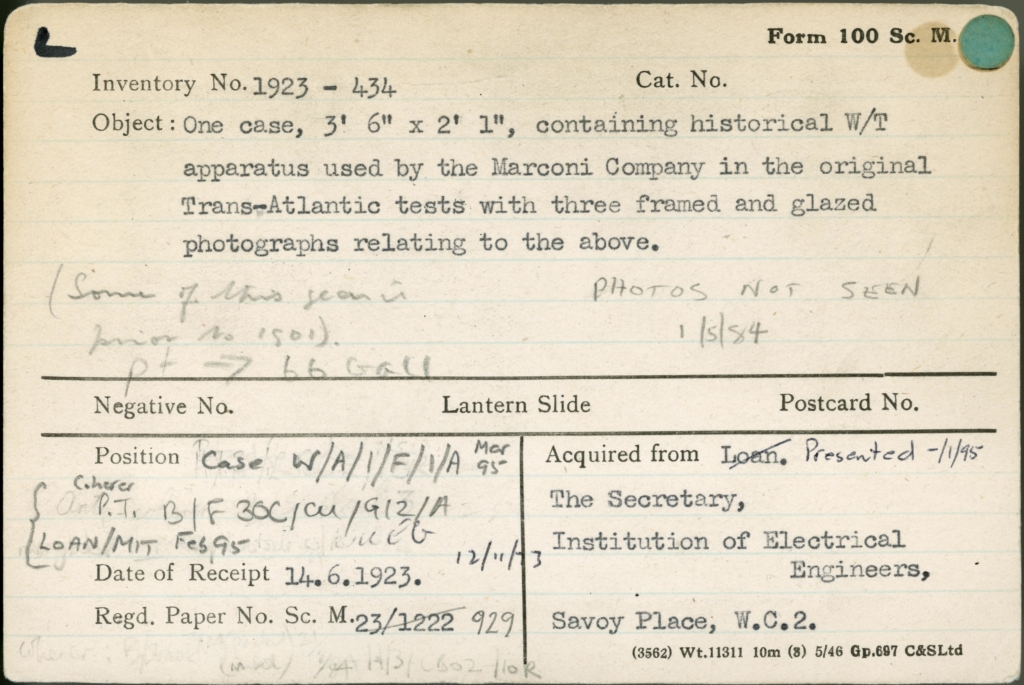
In the case of the medical collections, which were catalogued in the 1970s and early 1980s, the data were copied over from A4 catalogue cards including a multiplicity of standard fields dictated by the standards of the Museums Documentation Association (MDA) (later Collections Trust). These had recently been filled in to support the transfer of the Wellcome Collection to the Science Museum on permanent loan.
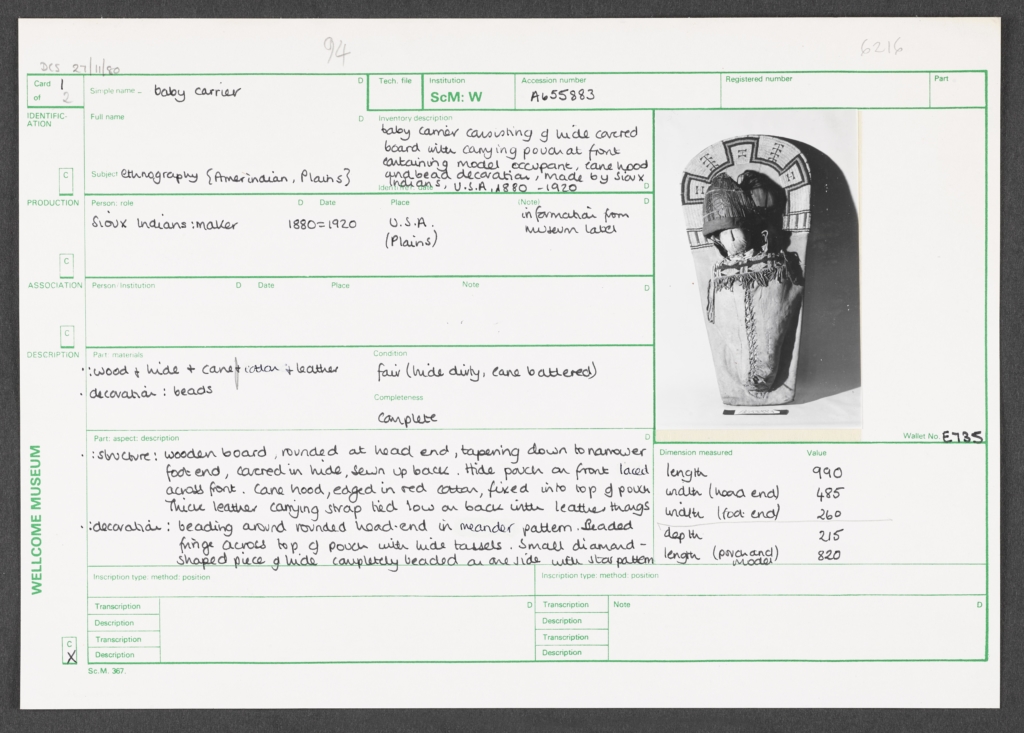
Museum Assistants and cataloguers in the Wellcome medical collection (including the author) worked obsessively with the computer records, making printouts and carrying them to the stores as they unpacked and laid-out collections at the old Post Office Savings Bank building in Hammersmith, repurposed as the Blythe House store (now in its turn being emptied into the National Collections Centre). On these printouts we marked up locations before (once more at the Museum) copying them over at the computer terminal, subtracting the ‘found’ from those whose location was not yet verified, generating a new printout and returning to the store for another round. Even this first data-centred version of computer-assisted curation had profound effects on the museum economy, as it led to a kind of zero-tolerance approach to the findability of inventoried objects that the previous paper-based systems had never produced. This exemplifies Ross Parry’s 2009 statement, ‘[t]oday, it is irrefutable that computing has had a profound effect on how museums manage and make visible their collections’ (Parry, 2009b, p 2). For a very few curators, the collections database would be the site for more learned and detailed cataloguing, and it was expected that whole sections of publications would derive from downloads of such data; this was the basis for the catalogue section of the heavyweight 1993 Public and Private Science: The King George III Collection, which was otherwise a series of serious and well-founded historical essays researched conventionally using paper archives and literature to contextualise the objects (Morton and Wess, 1993).[4] In the medical collections too, some of us followed an imagined telos that orderly layout of collections and database enhancement would lead to publication of new catalogues informed by recent scholarship, and thence to newly rich historical exhibitions. These catalogues failed to materialise as the Museum’s managers identified other, more visitor-facing uses for staff time.
The arrival of the Internet then World Wide Web in the 1990s and 2000s were actively seized on by museums, including SMG, to make their collections better known by presenting them in interpreted contexts. Here, the Ingenious, Making the Modern World website (for which, see Colson and Colson, 2009) and Brought to Life interpretive sites, conceived as differing kinds of online exhibitions, drew on the inventory database, which was – until the development of the Collections Online site in the last few years – only available online in a difficult to use and highly constrained form.[5] These interpretive websites were a new digital field of curatorial activity, and curators took to the new medium as a novel form of display work, selecting images as they might choose objects, and writing web text in place of panels and labels. Their hypertext links promised a kind of associative narrative impossible in spatial exhibitions where spatial proximity contains the range of possible juxtapositions. With its combination of scholarly research linking objects from museums across Europe, the Inventing Europe website is another antecedent of Congruence Engine’s interest. It draws associations between the collections of distributed cultural organisations with the aim of creating new historical narratives, in this case, the long-running Tensions of Europe project.[6]
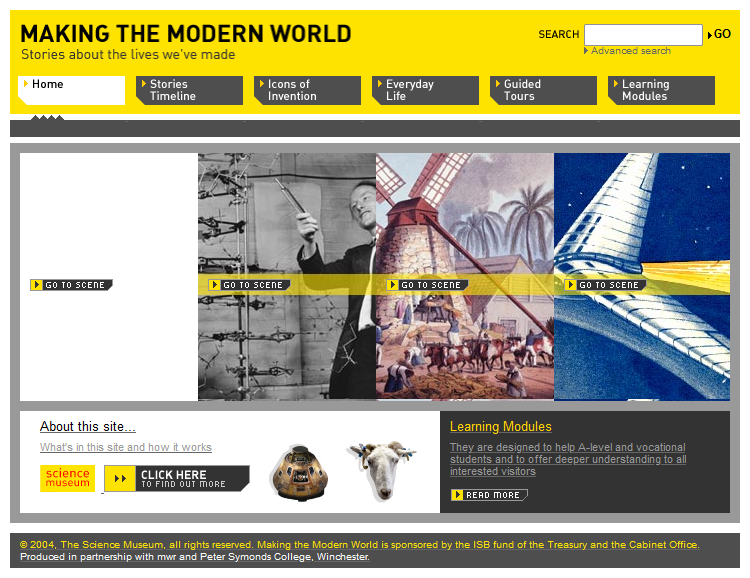
The aspirations for Ingenious are like an elder cousin to the current project: ‘using a vast variety of objects and images, we will weave connections between the people, innovations and ideas that have changed our lives and the way we see the world, from the Industrial Revolution to the present day (Bud, 2005, p 84). It took another few years for the decision to be made – and to be financially supported – to begin to make the collections fully available online, in a derivative of the Museum’s database (by this time long transferred from its original host computer and software to the ‘Mimsy’ relational database). This transfer, currently under way, has only been possible on the back of the funding to move the collections from Blythe House to the new National Collections Centre (NCC) at Wroughton near Swindon, on the airfield occupied since the 1980s by the Museum for its large object storage. Our current Collections Online pages are supplemented by substantial Objects and Stories webpages, somewhat in the Ingenious idiom, that, in a curated manner, provide scope for curators to write interpretively about the total collection.
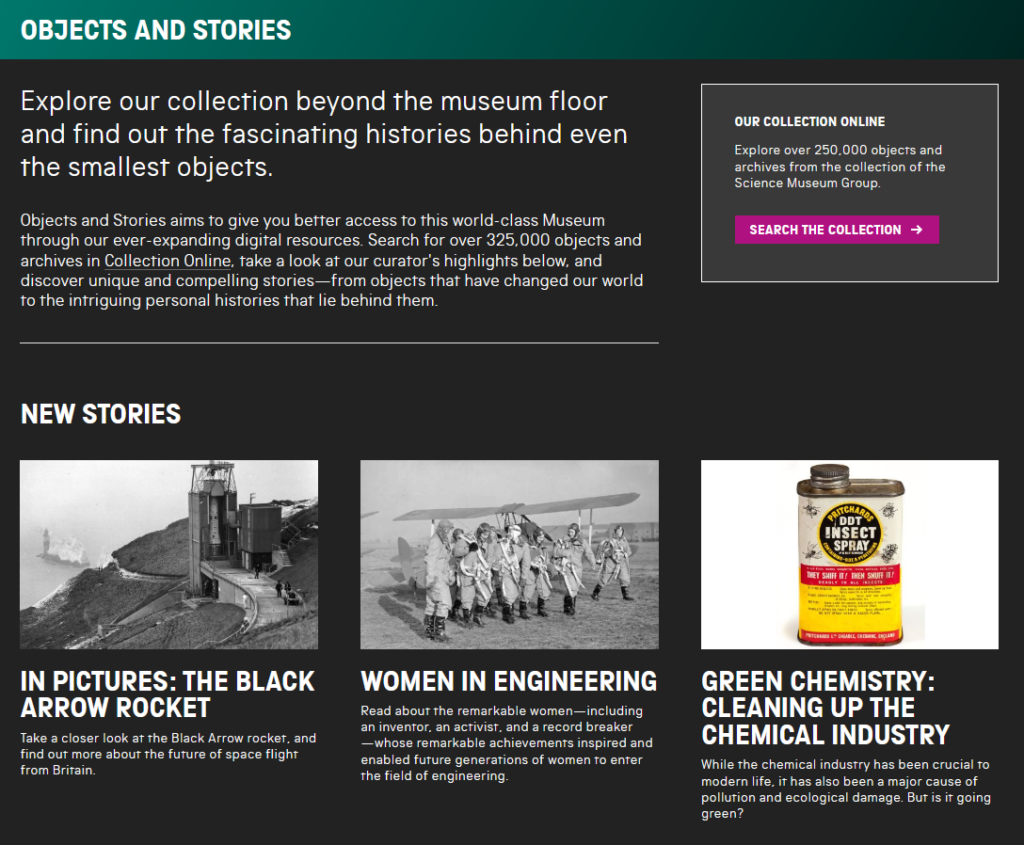
It may seem an inevitability that the Museum should become more digital in this way, even that it should have happened faster. But that is a Whiggish historical perspective. Consistently, and perhaps properly, museums have tended to direct the vast majority of their efforts and funds to front-of-house activities for large audiences, notably exhibitions and galleries. Reserve collections, actively espoused since 1951[7] (often explicitly for research purposes), have been catered for by, for example, provision of storage buildings, but have tended only to be prioritised for attention because of practical reasons, notably new displays or the need to move to new buildings. For SMG, cataloguing has not been a priority, except when collections have had to be moved (true in the cases of the Wellcome and the NCC moves), or research for new displays has provided new data, or else when senior collections staff have been sufficiently ‘immersed in practice’ to see the opportunity of funding streams (the New Opportunities Fund for Ingenious, Treasury Invest to Save for MMW, the long term relationship with the Wellcome Trust over the stewardship of their collection for Brought to Life) to pursue this kind of work.
It is interesting to note, in the context of the TaNC initiative, that the brief Treasury Organisation and Methods report section on the Science Museum concluded that ‘it would appear that any justification for processing such records by computer would need to rest on participation in a wider application of an inter-museum information service’ (Treasury, 1967). This suggests that our forebears, like those of us involved in TaNC, could conceive of a world of data bigger than their day-to-day experience, which would justify new tools to achieve ends beyond their everyday needs.
It is not possible yet to look back in a fully synthetic frame of mind on the impact of the digital revolution on museum practice in the way that we can at cinema, radio or television, for examples (though see Parry, 2009a). Rather, the TaNC enterprise is an opportunity to explore, to seek to understand better and to influence that revolution as it happens. The Museum’s developing digital activity has already included involvement in specifically digital research projects. Notably, the Science Museum was home to Heritage Connector, one of the eight foundation projects under the same TaNC funding.[8] This project developed a technique to associate within a knowledge graph related items from different collections as linked open data. It used artificial intelligence techniques such as named entity recognition to mine large quantities of online data about museum objects from the SMG collection, adjacent aspects of the V&A collection, and SMG online materials including its blog and the then text of this, our journal. The trained AI in the Named Entity Recognition program was able to find in the objects’ descriptive text particular categories: people, places, dates, numbers, organisations. Further programming was able to link these out from the Science Museum’s database to entities drawn from other online repositories, including Wikidata, the nearly 100-million strong database of unique entities (Dutia and Stack, 2021).[9]
This use of computing power to enhance collections access, as project research fellow Daniel Wilson has commented (this issue), may be seen as the late arrival of labour-saving techniques to the heritage sector to do a job – by other means gaining some of the benefits of expert cataloguing, which has heretofore been too expensive for institutions to achieve.
Changing relations between professional groups
New working practices very often arise in the context of technological change, bringing new trades and professions into existence. At the Science Museum, as in many cases, it was the librarians who were in the vanguard of what used to be called ‘computerising’ collections; Leonard Will, Keeper of the Library, led the project. Very soon it was necessary to appoint digital workers, including data processors and subsequently web experts, collections data managers and the rest. With such increases in efficiency and professionalism, curators’ control of data representing objects in their care has been ceded imperceptibly to such recently minted occupational classes. But as access to, and interpretation of collections (and their day-to-day management) becomes digital work, a question arises about how digital curatorial work could and should become, and what should be the role of digital expertise in curators’ work. At the same time, the differing occupational groups that are now engaged in activities that used to be undertaken by curators and clerks only will often inhabit different conceptual universes, use differing language, and be accustomed to differing work cultures. As Parry says of the wider field, each of the individuals working in museum digital work, who come from a variety of professional backgrounds:
typically has their own subject community or community of practice with which they routinely confer. This community may then be located in very different discursive spaces – curatorial/non-curatorial, academic/non-academic, technological/non-technological [and] … may have its own conventions for publishing and debate (Parry, 2009b, p 3).
It has become an emergent research question for Congruence Engine to consider whether these different expectations of the disciplines and professions united in the project are a hindrance to the formulation of the kinds of research enquiries that will enable true interdisciplinary work to be undertaken, realising the potential of the project’s aims (see Barry et al, 2008; Born and Barry, 2014).
At each stage so far of the development of digital methods in relation to museum collections, only the potentials of the immediate future have been evident: in 1967, that the Museum had no need of computers to record objects; in 1984, that computer listings would enable more efficient collections management; in the early 2000s, that online exhibitions would be able to provide to curators an output genre, parallel to what was at the time a somewhat diminished exhibitions programme. With Congruence Engine, we are drawing on developments in digital humanities, which have so far touched library and archive collections much more than the object collections of museums, to provide ways to associate items in collections. At the point of writing, nine months into the investigation, the precise potential for new kinds of digital curation is inchoate. For curators, it may be necessary to become more conscious and reflexive about the components of their practice, and to push, in the project’s experimental cycles, on the potentials of new digital analogues for established curatorial work. For both professional and amateur historians, it may be a matter of taking the dive into archives of material and visual culture that have most often at best been used in an illustrative fashion for histories written without a specific concern for objects and images (Jordanova, 2012). For all, there is the opportunity to learn from each other’s practice.
Ambitions
https://dx.doi.org/10.15180/221801/003Some of the ambitions for Congruence Engine are related to the intensification of existing programmes of work in the SMG Research and Public History Department, and others relate to possibilities that are emerging only because of the project and its funding. In 2015 we proposed three ‘meta-themes’ for Science Museum research: the public culture of science; its material culture; and its relationship with the arts. The idea was that, looking back at our activity at various intervals, we would be able to informally assess our relative success (Science Museum, 2016, p 7). In terms of the Department’s own active research programme, it is in the public culture of science that we have been most active, with one significant strand concerned with uniting collections with people who do varieties of the history of science and technology, whether as a paid pursuit or for fun. Here, forms of direct participation and co-production have been valuable as means to understand lay conceptions of the subjects we represent. A second strand, the intermedial study of science’s public culture, comprises mainly historical studies of the characteristics and ‘grammars’ of different science media, particularly museum display and moving image media, in contexts where science and technology are the subject. In short, we have one strand that has been mainly concerned with audiences, and another that has prioritised understanding the forms that have historically been adopted by the media that represent science, technology, and their past.
The public history of science
The public history of science and technology has been a signature concern of the SMG Research and Public History Department; indeed, this was the subject of our first and foundational AHRC-funded research network ‘Museums and the Public History of Science, Technology, Engineering and Medicine: Prospects and Issues’ (PHoSTEM).[10] The project brought together in discussion museum curators keen to enhance research into collections, university academics interested in gaining more impact for their research, and lay practitioners of industrial or scientific history. The reason for our stress on public history arises from the museum location of our research enterprise. Unlike established scholarly practice for which the main audience will most often be other scholars and their students, museum practice is most often focused on a diversity of visitors within the catch-all category, ‘the general public’ (which has, historically, been sliced in many different ways, latterly using ‘visitor segments’ defined using the techniques of marketing specialists).
But broaching the history of science with broad audiences very quickly becomes confounded with questions about science itself where, as Ken Alder has commented, there is an inherent tension:
… science, in the prevailing view, still designates that form of natural knowledge that winnows truth from error to produce a state-of-the-art summation of all and only those prior discoveries that possess current value. In this sense, science is an enterprise that swallows its own past. History, by contrast, is generally thought to offer a recapitulation of the past on its own terms and in a manner oblivious to the tug of present-day concerns (Alder, 2013).
Of course, in the absence of detailed social research, it is only an assumption that our visitors share the view that Alder describes, even though ‘prevailing view’ seems a safe assumption, given the dominant discourses of science communication. We, working on a similar assumption, have placed an emphasis on research to help us to understand how the public – our visitors and people like them – think about the past of science and technology. This public historical question is not at all the same as researching public attitudes to science, except insofar as members of the public have accepted that science has a transhistorical essence that would separate it from history. In other words, the subjectivity of museum visitors is an important part of how we have approached our public historical work, in which several varieties of participation have been central. This was signalled in the 2010 Conference, ‘Co-Curation and the Public History of Science’, which was built on the affinity between museum co-production and public history (Boon, 2011a). Several projects that seek to reveal the subjectivity of visitors in relation to the history of aspects of science and technology followed, notably the Oramics project, which enrolled people of differing levels of interest (including none) in the history of electronic music in Britain in co-producing an exhibition on the subject (Boon et al, 2014). It emerged here that the history of electronic music is a polysemic object; different kinds of people may carry different narratives of what matters to them about a subject that are often characterised by deep personal commitment.
Participation as a mode of museum work
These were some of the concerns that we brought to roles as co-investigators in projects funded under the cross-Research Council ‘Connected Communities’ theme led by the AHRC (Facer and Pahl, 2017). Most influential to our developing work in participatory research were the How are Heritage Decisions Made? project led by Helen Graham, and the Pararchive project led by Simon Popple, both now co-investigators in the current project. Heritage Decisions, with its fourteen investigators, action research methodology, wide view of heritage and two-stage co-production methodology, opened the door on how research can be a collaborative process. Emergent research questions and the potential for audiences to penetrate seemingly closed museum practices (such as the acquisition of objects to collections) showed how constructed such procedures may be, and revealed alternative approaches that could enable heritage practice to become more democratic (Graham, 2017). Graham latterly scaled-up her action research methodology (whose root is in Burns, 2007) in her Bradford’s National Museum project that linked the National Science and Media Museum with the diasporic communities of West Yorkshire.[11] Congruence Engine draws on the action research co-production methodology of both these projects, applying it to a new set of communities, namely those with pre-existing interests in history relatable to the industrial past. Pararchive, funded under a call uniting Connected Communities and Digital Futures AHRC themes, worked with several different community history groups. The outcome was the co-production of a web software platform, Yarn, that would support community storytelling combining privately-owned digital assets with those held in public collections.[12] The project worked experimentally with the Science Museum Group and the BBC, and one of the key aims was to make sure digital assets remained on their owners’ servers, thereby avoiding the complex rights-wrangling that often makes use of such collections difficult for historians in the community (see Popple and Mutibwa, 2016). Congruence Engine picks up from here not just via its use of the Yarn platform as a project tool, but also in emulating Parachive’s responsiveness to community groups wanting to pursue particular kinds of history using digital tools.
Intermedial histories
Intermedial comparison between museum displays (conceived of as one of ‘the media’) and other science media, notably television and film, has been an important strand of the SMG Research Department’s practice.[13] This began ten years ago with an AHRC exploratory award for the project Intermedial Science, under their then ‘emerging theme’, Science in Culture. In this six-month project, inspired by a paper by former colleague Ghislaine Lawrence (1990), we compared how the Science Museum and BBC science programmes, notably Horizon, had represented space and nuclear technologies in the 1950s and 1960s. Whereas Lawrence’s paper, comparing the BBC’s 1957 Your Life in Their Hands series with contemporary museum displays of medicine, had found broadcasting to be the more radical medium, Intermedial Science showed there to be significant similarities in the cultural framing of the museum and television media. It also showed that some of the Science Museum’s Keepers and Deputy Keepers in this period had in fact been as interested in the representational possibilities of their medium as were the television producers of the BBC in theirs (Gouyon, 2014a and b).
This project established the potential for more work on the different media of the public culture of science that would be sensitive to the peculiarities of each medium. That work continues.[14] But its potential within TaNC is to validate the linking together of different kinds of collection item. In Intermedial Science historical television programmes and exhibitions were linked using the connective tissue of written archives to explore and establish comparabilities. In Congruence Engine, we are extending this technique not primarily for the sake of analytical comparison between items in different kinds of collection but to propose an equalisation of the evidential potential of different kinds of collections item: objects, pictures, films, paper archives and the rest.
We have become aware of two related unstated assumptions in the TaNC enterprise that arise from the inter-collection way of working we are proposing. The first is that, if they could, people would want to work across collections. At the simpler level, we might envisage a search engine for UK collections, so that it would be possible to find, for example, all the artefacts of one kind in British collections, or everything associated with a single individual. Such a facility would undoubtedly be a boon to researchers, for all that its achievement with existing thin and inconsistent collections data presents a major technical challenge. The proof of concept demonstrated in the Heritage Connector project (already described) did not extend to addressing difficult issues of scalability to the national level or the sustainability of a giant knowledge graph that would need to retain live connections to multiple collections to remain up to date. Neither of these, which will be generic to all such technical solutions, is a major focus of Congruence Engine. But, as is becoming increasingly apparent as we pursue the research, building a technical solution without exploring the potentials for cross-collection working would only partially address TaNC’s aspirations.
Congruence Engine is much more concerned with the other untested assumption, namely the potential of linking collections for new kinds of historical and curatorial practice, both by people who are paid to do history, and those who do it for fun. We may note that historical and curatorial practice has changed across time, both because of wider social and cultural change and because of new technological affordances. (For example, the Science Museum ‘Forms 100’ that were the routine tools of collections management forty years ago are now historical artefacts themselves. Database records are used for that collections audit work now and, much of the time, it is not curators that conduct this work.)
Our tentative conclusion, which will be subjected to further research, is not so much that a national collection exists awaiting discovery, but that such a national collection must actively be created by acts of linkage. We suggest that the research desires of people who explore the past using its material – and intangible – sources should be the motor for creating a national collection; as we have begun to say: ‘to national collection’ – or perhaps ‘to realise a national collection’ – should be thought of as a verb, not a noun.[15] Or, again, that making a national collection will have to be an act of co-production between historians, curators, digital researchers and those non-human actors, the collections objects themselves (see Graham, 2016). And that is how we find ourselves, a quarter of the way into the project, realising the national collection will require a certain amount of vanguardism, of actively seeking out and proposing new applications for digital technologies in historical practice.
In that context it makes sense to observe that our first mini-investigations are showing that ontologically different components of the national collection – for example museum objects in comparison with data deriving from historical archives – are already doing different kinds of work within the project. Here is an example: a particular kind of Jacquard loom may be a node for connections, but a list of textile industry trades can also act as ‘connective tissue’ linking material artefacts (such as this loom) and the people who worked with it. These workers developed tacit skills of machine work that were core to the working sensorium of their lives, and these too we would seek to uncover and collect, for example, via the poems and lyrics of worker writers. For an example of this see the recent launch of Kirstie Blair’s Piston, Pen and Press project and database.[16]
Science, technology and the arts
Congruence Engine can also address our 2015 ambition to illuminate the theme of science, technology and the arts. This is partially because the formal and artistic qualities of collections items we will link are germane to the investigation – for example, the conventions of whether human figures are included in photographs of industrial workplaces – but also because there are kinds of artistic practice that use similar techniques to our own. For example, the artists’ collective The Brick Box, who presented at our opening conference, used oral histories and participation to create the projection artwork ‘The Mills are Alive’ at Listers Mill, Manningham, one of the foci of our first investigations.[17]
Research as a publicly visible component of museums
It is a necessary corollary of traditional museum research styles that their execution becomes somewhat invisible to visitors; it is virtually always a backroom activity, necessary to the running of the organisation, and especially to the creation of displays, but within the display medium itself reduced to being the invisible support and structure of what is eventually seen. That research is explicitly present only within the highly constrained word lengths that have become de rigeur for panels and labels in many modern museums. We may think of the research that invisibly supports displays as the scaffolding needed to support an arch but which is removed after insertion of the keystone: the ‘arch’ of the display stands up without the means that enabled it to be constructed in the first place (Boon, 2020). Similar arguments could be made for the research informing acquisition or conservation, for example.
One of the disadvantages here is that the potential for visitors of many kinds themselves to become researchers into collections is also not very visible. And yet, if the substantial reserve collections that many museums hold are going to fulfil their potential, then they are going to have to become the recourse of more than just the experts that were identified seventy years ago as their chief audience.[18] Here the participative core of Congruence Engine can model how people interested in various aspects of history may work with these extensive collections and use digital technique to do so, just as the Oramics project showed how participant subjectivity could be incorporated in exhibitions and Heritage Decisions pointed to more democratic collecting models for public museums.
Material constraints of space, staff and money will always mean that the numbers of exhibitions and galleries that a museum can produce will always be very limited, whilst the potential represented by museums’ reserve collections is infinite. TaNC, and Congruence Engine within it, look to find ways of exploring that infinitude, ways to make the collections visible and, to release the power of research by many people in realising that potential.
Potential subjects for investigation
The proposition of Congruence Engine is that for any individual or group with interests in industrial history, its methods may be able to support existing historical practice and generate new insights. In exploring TaNC’s second untested assumption – that linking collections of different kinds could enable new kinds of historical and curatorial practice – the project will have to display some vanguardism. That places a pleasant responsibility on the project’s investigators and researchers, singly and together with recruited participants, to define investigations that will test the proposition. Two potential examples follow. One possibility is to use the project’s digital humanities techniques to link industrial films from the BFI, including – to name a good potential topic – Paul Rotha’s fascinating 1935 film The Face of Britain (see Boon, 2000) to their many contexts; to places, people and objects shown on screen and to the enabling networks of technologies, finance and people that enabled films to be made in the first place. This would be a new kind of contextualisation for documentary film studies, enabling a film to be configured as a cluster of nodes within a network that would render it discoverable as part of multiple constellations of meaning and in association with many areas of interest. The history of museum displays contains within it another possible area of investigation. The choices made in museum digitisation have generally been to favour records of individual objects, even though within curatorial practice those objects have always been understood within a variety of broader cognitive structures, (including taxonomies, histories and the structures of particular displays). Accordingly, one investigation I would like to pursue across the project is to explore how such previous webs of meaning can be brought into the digital realm and thereby back to use in understanding collections now and in the future. The succession of different display organisations and juxtapositions of objects may be thought of as a series of alternate historiographies because each display configuration has voiced a particular account of its subject. Therefore, it will be interesting, where possible, to digitally reconstruct such exhibitions (at least at the level of picture, text and layout) with the aim of revealing the relation of display and narrative. Here we can draw on museum catalogues, such as that for the textile machinery collection (Science Museum, 1921) and archives, including of photographs. It would be interesting to work comparatively, perhaps by looking synchronically between different subjects displayed at the same time or diachronically between different exhibits of the same subject at different times; or, indeed, spatially between displays in different places and kinds of museum. Taking the Congruence Engine themes of textiles, energy and communications would provide a sufficiently broad canvas for this exercise. Here, Congruence Engine techniques would be enabling a new way of understanding the historiographies encoded in public displays by making available the ‘connective tissue’ by which our antecedent curators made sense of collections, which is currently inaccessible to digital methods.
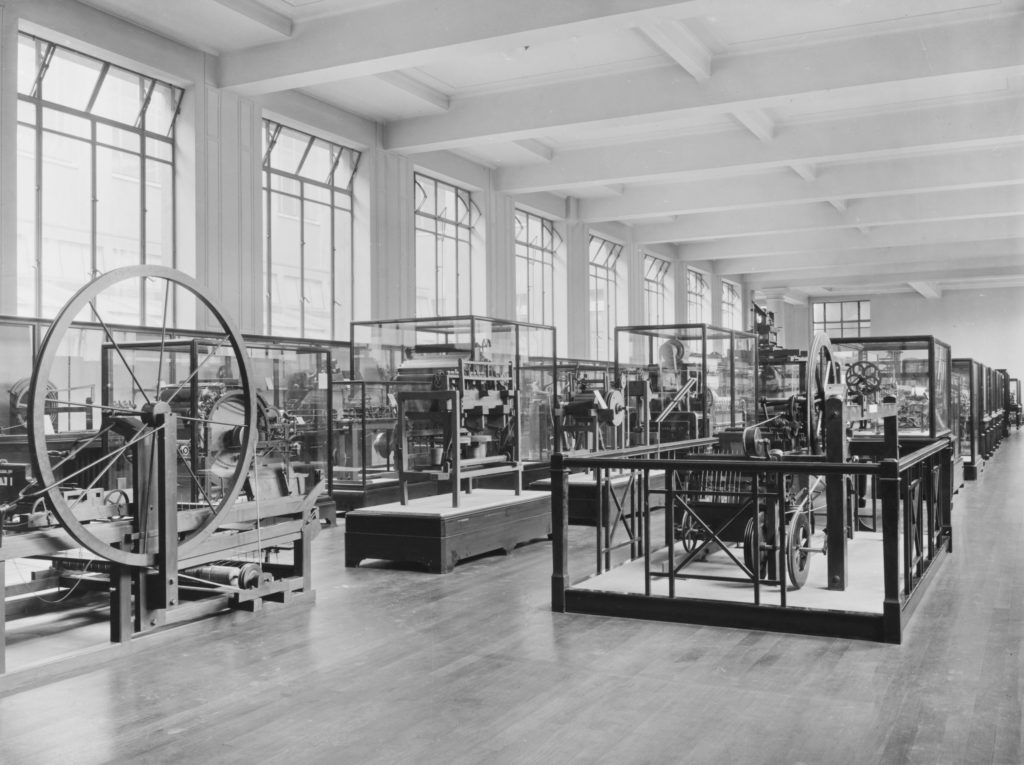
Conclusions
https://dx.doi.org/10.15180/221801/004Some 25 years ago, when I was a very acquisitive collecting Curator of Public Health, I acted on the basis that my task was to build a definitive collection for the Science Museum in my subject area; to understand the practice of public health and to represent it within the collection. Just occasionally this would involve competition with other collecting organisations. TaNC introduces a much more selfless prospect: that it is possible that what has been collected – whether in national, local, public or private, large or small collections – might be made accessible together without the centralising tendencies of a single national institution. Collections in their proper place might be ‘owned’ by all, available public-historically for intermedial, participative, and individual, study. And that study, unsnobbishly respecting the differing conventions and tastes of historians and curators in different places, might display historiographical styles that are as yet only dimly visible to us. Now, that would be a legacy for TaNC.
In sum, the Congruence Engine team is beginning to perceive a kind of historical practice, inspired by the associative bricolage that occurs in the creation of museum displays, that draws its power from the association of different kinds of historical object, each with its own affective and evidential register, giving rise to a kind of intermedial practice because it is inter-collection. In some ways, this ‘new practice’ would merely amplify what some historians have long done. The potential though, as we move up the scale from ‘hand-stitched’ historical accounts, absorbing the affordances of big data where they are available, is for much more rich and vivid accounts of our ancestors’ cultural and social experience. In its execution, our action research may also be seen as another example of being immersed in practice, but a practice that we are creating as we work.
Perhaps it goes without saying that the outcomes we imagine for this work will be of particular benefit to museums that hold substantial and currently unexploited reserve collections. But in the end, the potential implications are much more in opening-up new historiographical possibilities; to quote Paul Rotha’s commentary for his 1935 film The Face of Britain: ‘a new world lies waiting: there is much to be done!’
Acknowledgements
I would like to thank Arran Rees, Robert Bud and an anonymous referee for their advice in enabling the final version of this essay. More broadly, I acknowledge the debt of gratitude I owe to the many people I have had the pleasure to learn from in the many projects described above (you know who you are).


